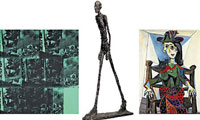 The Coy Art of the Mystery Bidder
The Coy Art of the Mystery Bidder From left, European Pressphoto Agency; Christie's; Sotheby's; Reuters
SECRET WALL POWER In recent years, anonymous bidders have paid record or near-record amounts for a Monet (“Le Bassin aux Nymphéas,” $80.4 million); a Warhol (“Green Car Crash,” $71.7 million); a Giacometti (“Walking Man I,” $104.3 million), and a Picasso (“Dora Maar With Cat,” $95.2 million). Buyers tend to be found out. The Giacometti bronze, for example went to the Brazilian-born billionaire Lily Safra.
If you follow art auctions even peripherally, you know that each one leaves a trail of question marks. Who bought the van Gogh? Who bought the Johns? We would very much like to know. Sooner or later we usually do.
But last week, when an anonymous telephone-bidding buyer paid $106.5 million for a 1932 Picasso — the highest price ever for a work of art at auction — the secrecy felt especially irksome. Who bought the painting repeatedly defined by Christie’s as a “trophy” with the tremendous visual impact that is now being called “wall power”? Who had the willpower to keep mum? To abstain from indulging fully in the spectacle of such a public act of acquisition? One — nearly everyone — itched to know; in fact, felt robbed of a crucial piece of the action. In other words, as with the season’s finale of one’s most addictive television show, one felt thoroughly and adroitly manipulated.
The superrich have always sent very public mixed signals about their need for privacy. In this case the headline-making price and the anonymous buyer made that paradox and its manipulative aspects especially clear. But how private does someone who buys a painting at public auction for a world-record price want to be?
Was it a Russian oligarch who didn’t want to call attention to himself, for fear of home invasion or too much unfriendly attention from Vladimir Putin? Was it a genuinely modest art lover who desired this particular Picasso beyond all else, would pay any price for it and wanted nothing so much as to quietly take it home, to an undisclosed location? More likely, it was someone in the vast gap between these extremes, perhaps someone with vast sums of money stashed in a Swiss bank account or a dubious tax shelter.
For a minute or two, I felt that the insistence on anonymity might qualify as mildly admirable behavior under the circumstances. It suggested that buying the picture, “Nude, Green Leaves and Bust,” wasn’t done just or even primarily for the attention. I thought of the relentless legacy opportunities that museums are pressed to create, slapping the names of trustees and donors on galleries, wings, auditoriums, facades, directorships, curatorial positions. (So far, I think, only full curatorial positions. I have yet to come across a Your-Name-Here Assistant Curator of Contemporary Art.) I remembered the enormous new wing of the Walker Art Center in Minneapolis, designed by Herzog & de Meuron and paid for by a family that preferred to remain anonymous. I wished someone like that would give $100 million to the New York Public Library and just let it go at that, no strings attached. Even more fatuously, I also wished that the Brody family, which put the Picasso on the block, had given it to a museum, settling for 50 years of private pleasure from a painting they loaned to an exhibition only once, plus their name in perpetuity on a modest pasteboard wall label.
That snapped me out of it. Strictly enforcing one’s privacy — at a time when so much goes public as fast at it happens — may be the ultimate public display of power, and thus the most erotic. The buyer is the puppet master whose puppets are the in-the-know few at Christie’s, from the top rank to the guy on the phone in the auction room relaying the bids. The rest of us don’t even need strings to be jerked around.
We look on, gape-mouthed, as the figure rises and then clamor to know. We think we are the observers, but actually we are the observed. It is Buyer X who is most in control and who therefore derives the greatest pleasure from the actual transaction. Anonymity only makes it that much more pleasurable and voyeuristic.
In this scenario, full disclosure becomes the relatively more admirable alternative, much the way it is with Oscar winners: someone standing teary-eyed at the microphone, saying how thrilled and humbled he is to be the owner of this fantastic painting. (“I’d like to thank my hedge-fund manager.”) Such openness might have given the event a veneer of normalcy. And it might have put our attention back on the art itself and made the whole thing less of a circus. But the art world and the world at large are now back in their boom-time positions regarding auctions, which is watching the money, oohing and ahhing and making the spending of it that much more of a turn-on.
Roberta Smith is an art critic for The Times.
 The Coy Art of the Mystery Bidder
The Coy Art of the Mystery Bidder